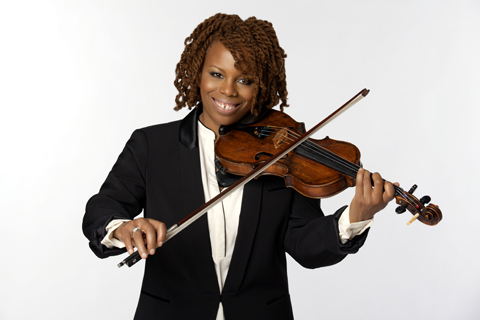
[Photo by David Katzenstein] |
If ever a musician understood the importance of exposure to music at an early age, it would be Regina Carter, who — family legend has it — at two years old, played a melody by ear on the piano after hearing her brother’s lesson. At four, she began studying the violin, and she hasn’t looked back since. From classical training as a teen and later at the New England Conservatory of Music in Boston, she switched to jazz at Michigan’s Oakland University and entered the Detroit jazz scene through trumpeter Marcus Belgrave.
After moving to New York in ’91 and releasing her first CD in ’95, she played with musicians as diverse as Aretha Franklin, Tanya Tucker, Steve Turre, and Mary K. Blige. Eight more of her own albums followed: one dedicated to the music of Detroit, one to the jazz standards of her mother’s time, one inspired by her African heritage and, most recently, 2014’s Southern Comfort, spurred on by the music her coalminer grandfather heard in Alabama and by field recordings from the Appalachian region.
In each of the albums, Carter re-interprets what she has heard and researched, giving each tune her own vision, as well as that special verve and distinctive polish she adds to her performances. She received a MacArthur “genius grant” in 2006 for being “a master of improvisational jazz violin.”
Carter brings the Regina Carter Quintet (Will Holshouser, accordion; Marvin Sewell, guitar; Chris Lightcap, bass; and Alvester Garnett, drums) to a FirstWorks concert October 18 at 8 pm at the RISD Auditorium. A free pre-concert conversation, “Cultural Identity and the Power of Improvisation” precedes it, 6:30 pm at RISD’s Chace Center (go to first-works.org for more info)..
The following is from a recent phone conversation with Carter:
What do you think is the role of the arts in young people’s lives? It’s crucial, even at a young age, that they are exposed to art, whether music, dance, or visual art. It’s been proven that it helps them to focus and gives them other options in life. It offers them a different viewpoint or different perspectives on the world.
And for those of us who aren’t musicians or artists, what is the role of the arts for adults? There’s an artist in each of us. Older people in some other field take a painting class or music class, and it offers relaxation. It’s a world away from their usual stressful lives.
What helps inspire creativity in young or old? Sometimes it’s just stepping outside our comfort zone or doing something we haven’t done before. You’ve exposed yourself to something, and if you love it, you might explore that more. If you hate it, and say, “That I didn’t like,” at least you recognize that. It awakens something in you.
What’s important about bringing new work or new performers to audiences, as is FirstWorks’s goal? The important thing in the end is that people have the experience. It made you laugh or bothered you or made you think about something else. What it brings up in each of us — the artist can’t control that, but it’s beautiful. Sometimes something from across the world can bring that spark to them and inspire curiosity.